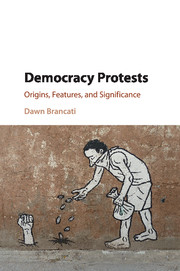Book contents
- Frontmatter
- Dedication
- Contents
- List of Figures
- List of Tables
- Acknowledgments
- 1 Introduction
- 2 Characteristics of Democracy Protests
- 3 Relating Economic Crises to Democracy
- 4 Analyzing the Rise of Democracy Protests
- 5 Analyzing Elections as Trigger Events
- 6 Historical Trends in Government Responses
- 7 Analyzing Political Accommodation
- 8 Historical Trends in Democratization
- 9 Analyzing Democratization
- 10 Conclusion
- Appendix: Data and Measures
- References
- Index
2 - Characteristics of Democracy Protests
Published online by Cambridge University Press: 05 September 2016
- Frontmatter
- Dedication
- Contents
- List of Figures
- List of Tables
- Acknowledgments
- 1 Introduction
- 2 Characteristics of Democracy Protests
- 3 Relating Economic Crises to Democracy
- 4 Analyzing the Rise of Democracy Protests
- 5 Analyzing Elections as Trigger Events
- 6 Historical Trends in Government Responses
- 7 Analyzing Political Accommodation
- 8 Historical Trends in Democratization
- 9 Analyzing Democratization
- 10 Conclusion
- Appendix: Data and Measures
- References
- Index
Summary
Democracy protests have at their core the demand for open and competitive elections, but they vary along many other dimensions, including their size and duration, their particular demands regarding democracy, and the strategies they use to achieve their goals. In this chapter, I characterize democracy protests along each of these dimensions in order to structure the subsequent debate and analysis on why democracy protests arise and how governments respond to them. In sum, most democracy protests in the post–Cold War period did not pose a major threat to regimes. In general, they were short-lived, attracted few participants, were confined to capital cities, and made only moderate demands on governments. However, democracy protests did employ violent tactics – hurling stones, setting tires ablaze, storming buildings, and so forth – to achieve their goals nearly as often as they used peaceful ones.
WHO ORGANIZES DEMOCRACY PROTESTS?
In general, democracy protests do not emerge spontaneously from among the public, but rather are carefully planned by actors both inside and outside government. In fact, only slightly more than a quarter of all democracy protests that occurred between 1989 and 2011 emerged in the absence of any organizers. (See Figure 2.1.) These protests primarily emerged among supporters of certain political parties or candidates after the announcement of an election result unfavorable to their candidate. The remainder of democracy protests in the post–Cold War period was organized by political parties and individual candidates or civil society groups. Their organizational responsibilities ranged from limited forms of involvement, such as exhorting sympathizers to take to the streets, to more significant forms of engagement, such as applying for permits, arranging speakers for rallies, printing signs, and so forth.
Political parties organized more democracy protests in this period than civil society groups. In a number of cases, including the Ukraine's Orange Revolution and Iran's Green Revolution, the protests themselves derived their names from the opposition parties’ colors, highlighting the importance of these parties to the protests. Orange, for example, was the campaign color of Viktor Yushchenko although it has often been mistakenly attributed to the failed attempt to assassinate Yushchenko with dioxin, a contaminant in Agent Orange.
- Type
- Chapter
- Information
- Democracy ProtestsOrigins, Features, and Significance, pp. 18 - 38Publisher: Cambridge University PressPrint publication year: 2016



